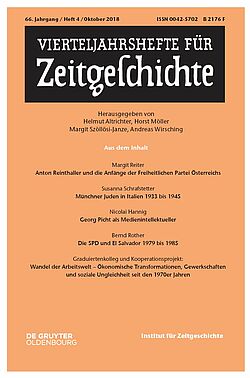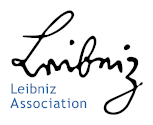- The Institute
- Research
- Dictatorships in the 20th Century
- Democracies and their Historical Self-Perceptions
- Transformations in Most Recent History
- International and Transnational Relations
- Edited Source Collections
- Dissertation Projects
- Completed Projects
- Dokumentation Obersalzberg
- Center for Holocaust Studies
- Berlin Center for Cold War Studies
- Publications
- Vierteljahrshefte
- The Archives
- Library
- Center for Holocaust Studies
- News
- Dates
- Press
- Recent Publications
- News from the Institute
- Topics
- Munich 1972
- Confronting Decline
- Feminist, Pacifist, Provocateur
- Der Mauerbau als Audiowalk
- Digital Contemporary History
- Transportation in Germany
- Envisaged Futures at the End of the Cold War
- From the Reichsbank to the Bundesbank
- German Federal Chancellery
- History of Sustainabilities: Discourses and Practices since the 1970s
- Changing Work
- Democratic Culture and the Nazi Past
- The History of the Treuhandanstalt
- Foreign Policy Documentation (AAPD)
- Dokumentation Obersalzberg
- Hitler, Mein Kampf. A Critical Edition
- "Man hört, man spricht"
- IfZ
- Vierteljahrshefte
- VfZ Archive
- Issue Index
- Issue October 2018
Issue 4/2018
Content Overview: English Titles and Abstracts:
- Margit Reiter: Anton Reinthaller and the Beginnings of the Freedom Party of Austria. On the Political Formation of Former Nazis in Austria.
- Susanna Schrafstetter: Between Scylla and Charybdis? Munich Jews in Italy, 1933 to 1945.
- Nicolai Hannig: Georg Picht. Strategies of a Media Intellectual in the West German Public Sphere.
- Bernd Rother:The SPD and El Salvador, 1979 to 1985. Left-Wing Politics in the Atlantic Triangle between West Germany, Central American and the USA.
Abstracts
Margit Reiter, Anton Reinthaller and the Beginnings of the Freedom Party of Austria. On the Political Formation of Former Nazis in Austria
After 1949, many former National Socialists reorganised themselves in the Federation of Independents (Verband der Unabhängigen, VdU) and its successor party, the Freedom Party of Austria (Freiheitliche Partei Österreichs, FPÖ). As the first party leader of the FPÖ since 1955/56, Anton Reinthaller (1895–1958) played a central role in the political formation of the “Ehemalige” (former Nazi Party members). On the basis of the hitherto unused papers of Anton Reinthaller, the present contribution sketches the political career of the founder of the FPÖ from his time as an illegal National Socialist during Austrofascism, his appointment as a Nazi minister in 1938 and his various positions during the Nazi period up to his political biography after 1945. The correspondence, personal notes and court documents contained in his papers not only provide a good overview of the networks and the discourse among former Nazis after 1945, but also allow for the investigation of Reinthaller’s position towards National Socialism and his retrospective self-presentations. The early history of the FPÖ is investigated by interlacing organisational history and a biographical approach: In its tension between biographical and ideological continuities on the one hand and the willingness and capability to adapt to different political circumstances on the other hand, the example of Anton Reinthaller reveals a typical “Austrian” perpetrator biography which has not been given much attention by research to date.
Susanna Schrafstetter, Between Scylla and Charybdis? Munich Jews in Italy, 1933 to 1945
Why did Jews from Germany seek refuge in fascist Italy? When did they go to Italy? How did they experience life in exile, during internment, and under German occupation? Based on the stories of 400 Munich Jews who fled to Italy between 1933 and 1940, Susanna Schrafstetter shows that emigration and flight to Italy were closely related to the expulsion of Jews of Polish background from Germany. A large percentage of the Munich Jews who arrived in Italy in 1939/40 possessed Polish passports. Whereas most foreign Jews left Italy after the promulgation of the Italian racial laws of 1938, not all of them were able to emigrate from Italy to other countries. The majority of those who remained, or were forced to remain, were interned after Italy’s entry into the war in June 1940. The author describes the internment of the Munich Jews and demonstrates that nearly all of them were confronted with illness and suffering. Upon the German occupation of the Italian peninsula in September 1943, all Jews were threatened with arrest, deportation, and murder. Susanna Schrafstetter investigates regional differences in the implementation of persecution, and additionally sheds light on the heretofore insufficiently understood fate of Jewish partners in mixed marriages in Italy under German occupation.
Nicolai Hannig, Georg Picht. Strategies of a Media Intellectual in the West German Public Sphere
In the intellectual debates of West Germany, Georg Picht was always present. He dealt with educational and peace policy, the protection of the environment, development aid, demographic development and the global food crisis. He involved himself in the activities of government agencies and engaged in political consultancy. Yet the core of Picht’s political activities was his journalistic work. Like few other intellectuals of the old West Germany, Picht was prominently present in the media. He was covered by the media and positioned himself in the media. Picht was capable of using the public attention he had created to portray himself as an idea provider on the one hand and as a competent organiser on the other hand. His media presence was not purely calculated and strategic, however. It was also a form of adaptation and shaped the character of the newly developing archetype of the media intellectual. Using Picht and his journalistic activities as an example, the article shows how intellectuals adapted to the media logic of the second half of the 20th century and were ready to let themselves be taken in by its production mechanisms.
Bernd Rother, The SPD and El Salvador, 1979 to 1985. Left-Wing Politics in the Atlantic Triangle between West Germany, Central American and the USA
Shortly after the overthrow of the Somoza dictatorship by the Sandinistas in Nicaragua in the summer of 1979, a unique political constellation emerged in El Salvador in the early 1980s. An association of guerrilla groups, which was allied with the Social Democratic Movimiento Nacional Revolucionario (MNR), attempted to overthrow the Christian Democratic led government, which was supported by the USA. Through common membership in the Socialist International, the SPD became a player within this conflict and supported the MNR. The SPD wanted to show that social revolutionary movements in the Third World could (unlike in the case of Cuba in 1959) garner help not just in Moscow, provided they were ready to acknowledge democratic principles. In doing so, the SPD was exposed to accusations of anti-Americanism and of collaborating with left-wing radicals both at home and from the USA. The activities in Central America were part of a new global strategy of the SPD. In the case of El Salvador, they finally resulted in efforts to reach a negotiated solution to the conflict, also in cooperation with the Centrist Democrat International.
04/09/2024
„Die Lebensbeichte des Bandera-Mörders“
Der "Münchner Merkur" zu Grzegorz Rossoliński-Liebes Dokumentation im Aprilheft der VfZ
mehr
04/04/2024
„Die Beichte des Mörders von Stepan Bandera“
Die „Süddeutsche Zeitung“ zu Grzegorz Rossoliński-Liebes Dokumentation im Aprilheft der VfZ
mehr
04/02/2024
Druckfrisch: VfZ 2/2024
Das Aprilheft der Vierteljahrshefte für Zeitgeschichte ist erschienen
mehr








